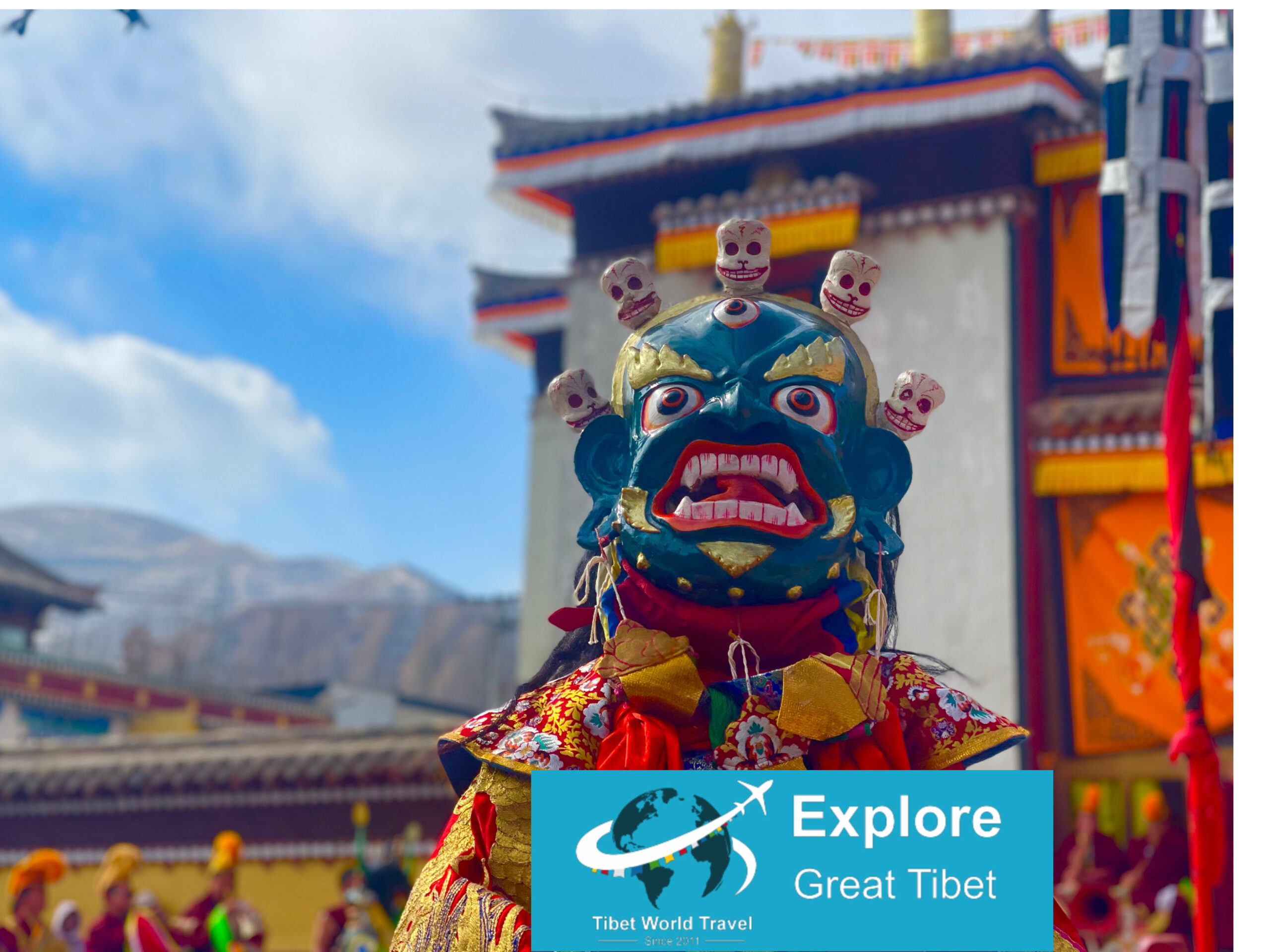History:
The Monlam Festival (Tibetan: སྨོན་ལམ།, meaning “Prayer Festival”), also known as the Great Prayer Festival, is one of the most important religious festivals in Tibetan Buddhism, particularly in the Amdo region of Tibet (present-day Qinghai Province). It is celebrated by the Tibetan people across the Tibetan Plateau, including Amdo, Ü-Tsang, and Kham, but the version in Amdo has a unique regional flavor due to the area’s cultural and historical context.

Monlam takes place during the first month of the Tibetan lunar calendar, culminating around the 15th day, and is dedicated to prayers for world peace, the well-being of all sentient beings, and the long life of spiritual leaders. Monks from different monasteries gather to perform large-scale rituals, prayers, and processions during this festival, making it a time of spiritual renewal for both the clergy and laypeople.
Key Features of the Monlam Festival in Amdo:
Historical Significance:
The Monlam Festival was first established in 1409 by the great Tibetan philosopher and founder of the Gelug school, Je Tsongkhapa (1357–1419), in Lhasa. The festival began as a way to celebrate the Mahayana Buddhist teachings and to pray for the long life of Buddhist teachers, peace in the world, and the prosperity of Tibet. In Amdo, the festival carries additional significance as the region is the birthplace of Tsongkhapa himself, in Tsongkha (now Huangzhong in Qinghai). His legacy is particularly strong in this region, and the celebration of Monlam is an important part of Amdo’s Buddhist traditions.
Prayers and Ceremonies: A Thousand Voices, One Aspiration
The heart of the Monlam Festival is the recitation of prayers for world peace and the well-being of all beings. These prayers are chanted in unison by monks and laypeople, creating a powerful spiritual atmosphere. The gathering of monks from different monasteries, especially the major Gelugpa monasteries like Labrang, Kumbum, and Rebkong, is a highlight of the festival. The prayers are often accompanied by the burning of incense, lighting of butter lamps, and making offerings to the deities. These acts symbolize purification, wisdom, and the dispelling of ignorance, all of which are central to the goals of the Monlam Festival.
Flames of Devotion, Sculpted in Butter
A significant feature of the Monlam Festival in Amdo is the creation of intricate butter sculptures and sand mandalas. These sculptures, called torma, are made from butter dyed in various colors and depict deities, animals, and other symbolic imagery. Monks spend weeks creating mandalas out of colored sand, representing the universe in Buddhist cosmology. The mandalas are eventually destroyed at the end of the festival, symbolizing the impermanence of all things and the transitory nature of life. The butter sculptures, particularly in Labrang Monastery, are elaborate and displayed for the public during the festival, drawing large crowds of pilgrims and visitors.
Monastic Debates:
Another distinctive feature of Monlam is the monastic debates (Tibetan: chos rtsod). Monks engage in vigorous intellectual debates about Buddhist philosophy, doctrine, and logic. These debates are not just academic but are a spiritual exercise aimed at sharpening the mind and deepening one’s understanding of the teachings of the Buddha.
In Amdo, monasteries such as Labrang Tashikyil Monastery and Kumbum Monastery hold prominent debate sessions, where hundreds of monks participate, displaying their skills in logic and dialectics.
Public Participation:
For laypeople, Monlam is a time for pilgrimage and devotion. Thousands of Tibetan Buddhists from across Amdo and beyond make the journey to major monasteries to participate in the rituals, receive blessings, and accumulate spiritual merit.
Devotees engage in kora (circumambulation) around the monasteries and sacred sites, spin prayer wheels, and make offerings, such as butter lamps, flowers, and money. They also participate in prostrations—a form of deep prayer and physical devotion, where pilgrims stretch out on the ground before rising again, often repeating this act for long distances around the monastery.
Dance of the Celestial Protectors
One of the most visually stunning aspects of the Monlam Festival is the performance of Cham dances. These ritual dances are performed by monks wearing elaborate masks and costumes representing Buddhist deities, protectors, and demons. The dances serve both as a form of meditation in movement and as a way to impart spiritual teachings through symbolism. The Cham dances depict important Buddhist stories, including the triumph of good over evil and the overcoming of obstacles to enlightenment. In Amdo, these dances are especially popular and draw large crowds of both locals and pilgrims.
Display of the Giant Thangka (Buddha Images):
Threads of Enlightenment
In many monasteries across Amdo, including Labrang and Kumbum, the Monlam Festival includes the unveiling of massive thangka paintings of the Buddha, which are often displayed on the mountainside or on large walls.
These gigantic silk appliqué thangkas are often several stories tall and depict the Buddha in various forms, including the Maitreya Buddha (the Buddha of the Future) or the Thousand-armed Avalokiteshvara (the Bodhisattva of Compassion). The unveiling is a moment of great reverence, and people gather to offer prayers and make prostrations in front of the thangka.
Folk Festivals and Horse Races:
In some areas of Amdo, especially in the more rural parts where Tibetan nomadic culture is still strong, Monlam is also a time for folk celebrations and festivities. These may include horse races, archery competitions, and other traditional games. In these settings, Monlam blends with local culture, bringing together religious devotion and communal celebration.
The festival becomes a social gathering, where people reconnect with family and friends, wearing their best traditional clothing and sharing in communal meals and prayers.
Regional Variations:
In Amdo, each monastery and community may have its own variation of the Monlam Festival. While the central theme of prayer and devotion is consistent, certain customs or rituals may vary based on local traditions or the particular sect of Tibetan Buddhism practiced in the area.
The region’s vast geography, covering parts of Qinghai, Gansu, and Sichuan provinces, gives rise to unique regional expressions of Monlam, from the remote nomadic settlements to the large monastic centers.
Spiritual and Cultural Significance:
The Monlam Festival is not only a religious event but also a cultural celebration that reinforces Tibetan identity, especially in the Amdo region. It is a time when Tibetan communities gather to celebrate their spiritual heritage, foster social bonds, and engage in acts of kindness and generosity.
For the Tibetan Buddhist community, Monlam offers an opportunity to renew one’s spiritual commitment, receive teachings from the lamas, and connect with the lineage of Tibetan Buddhism that has been passed down for centuries.
Activities
The main activities for the festival are examinations for the ‘Lharampa’ degree (a high degree in Buddhist philosophy). Performance of traditional Tibetan Buddhist dances (Cham) and display giant Thangka paintings. And huge ritual offering cakes (Tormas) that were adorned with very elaborate butter sculptures. On the fifteenth day, the highlight of Monlam Chenmo would be the “Butter Lamp Festival” (Metok Cholpa).
Schedule for Monlam Festival in Rebkong
|
Monasteries |
Lunar |
|
Giant Thangka Display |
Jampa Lingkor |
Cham Dance |
|
Yigar Monastery |
1st – 5th |
|
5th |
|
|
|
Lower Wutun Monastery |
1st – 10th |
|
8th |
9th |
10th |
|
Upper Wutun Monastery |
1st – 8th |
|
5th |
6th |
7th |
|
Gartse Monastery |
11th – 15th |
|
13th |
15th |
13th |
|
ShelGon Monastery |
4th – 13th June |
10th |
11th |
|
12th June |
|
Dzongkar Monastery |
11th – 16th |
|
10th |
15th |
16th |
|
YerShung Monastery |
7th – 15th April |
|
12th |
13th |
|
|
Kasar Monastery |
5th – 8th |
|
5th |
|
|
|
Gomar Monastery |
5th – 11th |
8th |
9th |
10th |
11th |
|
Nyanthog Monastery |
9th -13th |
11th |
12th |
13th |
|
|
Bongya Monastery |
4th -9th |
|
5th |
9th |
7th |
|
Togya Bonkor Monastery |
|
|
8th |
|
|
|
KyungGon Monastery |
8th – 13th |
|
|
|
12th |
|
Darzhin Monastery |
2nd – 5th |
|
|
5th |
|
|
Rongwo Gonchen |
10th – 16th |
13th |
14th |
15th |
16th |
Schedule for Monlam Festival in Gannan
|
Monasteries |
Lunar |
Free Animals |
Giant Thangka Display |
Jampa Lingkor |
Cham Dance |
Display Butter Sculpture |
|
Labrang |
8th – 16th |
8th |
13th |
16th |
14th |
15th |
|
Hezuo |
8th – 16th |
8th |
13th |
16th |
14th |
15th |
|
Luchu |
8th – 16th |
8th |
13th |
16th |
14th |
15th |
|
Langmusi |
8th – 16th |
8th |
13th |
16th |
14th |
15th |
Schedule for Monlam Festival in Ngawa
|
Monasteries |
Lunar |
Free Animals |
Giant Thangka Display |
Jampa Lingkor |
Cham Dance |
Display Butter Sculpture |
|
Gomang |
3rd – 15th |
8th |
13th |
16th |
14th |
15th |
|
Kirti |
3rd – 15th |
8th |
13th |
16th |
14th |
15th |
|
Nangzhik |
3rd – 15th |
8th |
13th |
16th |
14th |
15th |















